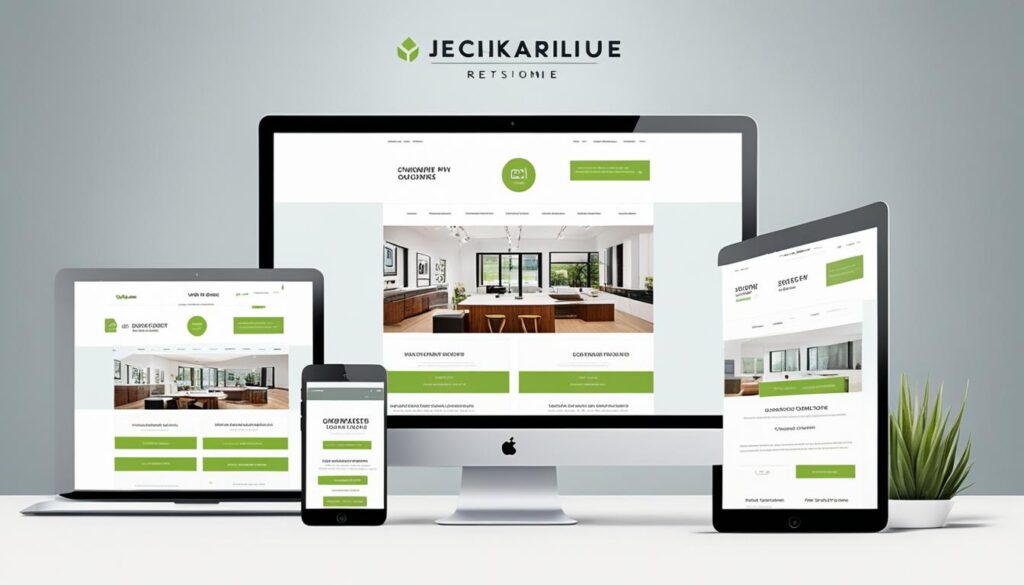Need a New Website For Small Business? Have you ever walked into a store and immediately felt a sense of excitement and anticipation? The beautifully designed displays, the carefully curated products, and the friendly staff all creating a truly immersive experience. It’s a feeling that stays with you, making you want to return again and again.
Well, imagine if that same feeling could be translated into the online world. Imagine if your small business website could evoke the same emotions and captivate your audience from the moment they arrive. This is not only possible but essential for unlocking the full potential of your small business.
It’s no secret that the online landscape has become increasingly integral to the success of small businesses. Your website is not just a virtual storefront; it’s the gateway to your brand, your products, and your services. It’s the first impression you make on potential customers, and it’s crucial that it leaves a lasting impact.
But how do you know if your website is still up to par? How can you tell if it’s time for an upgrade to take your online presence to the next level? In this article, we will explore the signs that indicate your website needs an upgrade now!
Key Takeaways:
- A well-designed website is crucial for unlocking your small business’s full potential.
- Your website is the virtual storefront of your brand and should captivate your audience.
- We will explore the signs that indicate your website needs an upgrade.
Understanding the Importance of a Modern Online Presence for Small Business
In today’s digital marketplace, small businesses need to establish a strong online presence to stay competitive and achieve success. A modern online presence is essential for attracting customers, driving growth, and distinguishing your business from the competition.
Staying Competitive in Today’s Digital Marketplace
The digital marketplace is crowded with businesses vying for attention. To stand out and attract customers, it’s crucial to have a modern online presence. This means having a website that not only looks professional but also provides a seamless user experience. A visually appealing website with intuitive navigation and responsive design will engage visitors and encourage them to explore further, increasing the chances of converting them into customers.
The Link Between Professional Website Design and Business Growth
A professionally designed website is not just a means of showcasing your products or services; it serves as the digital face of your business. A well-designed website that reflects your brand identity instills trust and credibility in potential customers. It creates a positive first impression and persuades visitors to choose your business over competitors.
Moreover, a professional website design is crucial for driving business growth. It improves customer engagement by providing an intuitive and user-friendly experience, increasing the chances of conversions and repeat business. It also helps in improving search engine visibility, making it easier for potential customers to find your business online.
By investing in a modern website design, small businesses can position themselves as leaders in their industry, establish credibility, and attract a wider customer base. A professional website design is a powerful tool that unlocks the potential for small business success in today’s digital era.
Is Your Small Business Website Turning Customers Away?
Your small business website may be the first point of contact for potential customers. However, if it is not meeting their expectations, it could be turning them away. In this section, we will identify the signs that indicate your website is driving customers away. From slow loading times to poor navigation, we will explore the common pitfalls that can negatively impact the customer experience. By being aware of these issues, you can take steps to improve your website and retain customers.

Strategies for Improving Website User Experience and Retention
To ensure your website delivers an exceptional user experience and retains customers, it is essential to implement effective strategies. In this section, we will discuss the key elements of a user-friendly website design, including responsive layouts, intuitive navigation, and engaging content. We will also explore techniques for enhancing website navigation and improving content accessibility. By implementing these strategies, you can create a website that keeps visitors engaged and encourages them to return.
Key Elements of a User-Friendly Website
A user-friendly website design is crucial for providing a positive website user experience. Here are some key elements to consider:
- Responsive Layouts: Ensure your website is compatible with different screen sizes and devices, allowing users to access your site conveniently on desktops, tablets, and mobile phones.
- Clear and Intuitive Navigation: Simplify website navigation by organizing content and menus logically, making it easy for users to find the information they need.
- Engaging Content: Create high-quality, relevant, and engaging content that captivates visitors, keeping them interested and encouraging them to explore your website further.
- Fast Page Load Times: Optimize your website’s performance by reducing loading times, enabling users to access your content quickly and efficiently.
Enhancing Navigation and Content Accessibility
Improving website navigation and content accessibility can significantly enhance the user experience. Here are some techniques to achieve these goals:
- Intuitive Menu Structure: Design a clear and intuitive menu structure that allows users to navigate your website effortlessly. Use descriptive labels and organize menu items logically.
- Search Functionality: Implement a search bar that enables users to find specific content quickly. Include advanced search features to refine search results and enhance usability.
- Consistent Website Layout: Maintain consistency throughout your website by using the same layout and design elements across different pages. This helps users familiarize themselves with your site and navigate it more efficiently.
- Accessible Content: Ensure your website content is accessible to all users, including those with disabilities. Use alt tags for images, provide text transcripts for audio and video content, and make sure your website is compatible with screen readers.
By implementing these strategies and focusing on website user experience, you can create a user-friendly website that not only attracts visitors but also retains them. The key is to provide a seamless and intuitive browsing experience while delivering high-quality content that meets the needs and expectations of your target audience.
Responsive Web Design: Why Your Site Must Look Good on Any Device
As the use of mobile devices continues to rise, it is crucial for small businesses to have a responsive website. Responsive web design ensures that your site looks good and functions well on any device, whether it’s a smartphone, tablet, or desktop computer. In this section, we will explore the importance of responsive web design and the benefits it brings to your online presence.

A responsive website adapts to different screen sizes and resolutions, providing an optimal viewing experience for users. It allows your website to dynamically adjust its layout and content based on the device being used, ensuring that visitors can easily navigate and engage with your site, regardless of the screen size they are using.
Having a mobile-friendly website is essential for improving user experience. When your site is responsive, it loads quickly and displays content in a user-friendly format, eliminating the need for users to zoom in or scroll horizontally. This enhances user satisfaction, keeps visitors on your site longer, and encourages them to explore more of your products or services.
In addition to improving user experience, responsive web design also boosts your search engine visibility. Search engines like Google prioritize mobile-friendly websites in their search results, as they aim to deliver the best user experience to their users. By having a mobile-friendly site, you increase your chances of achieving higher search rankings, attracting more organic traffic, and ultimately driving more conversions for your small business.
By ensuring that your website is accessible across all devices, you can reach a wider audience and enhance your online presence. A responsive website portrays professionalism and demonstrates that your business is keeping up with the latest technology trends. It allows you to cater to the needs and preferences of your target audience, regardless of the device they use to access your site.
Investing in responsive web design is not just about staying relevant; it’s about providing the best possible experience for your website visitors. With more and more people using mobile devices to browse the internet, having a mobile-friendly website is no longer optional. It’s a necessity for small businesses looking to thrive in today’s digital landscape.
The Telltale Signs of Outdated Website Technology and Design
An outdated website design can have a detrimental impact on your business and hinder growth. In this section, we will explore the telltale signs that indicate outdated website technology and design. By recognizing these signs, you can take necessary steps to update your website and ensure it remains competitive in today’s digital landscape.
Recognising an Antiquated Website Layout
One of the key indicators of an outdated website is an antiquated layout. This includes cluttered pages, excessive use of pop-ups, and outdated navigation menus. An outdated layout can make it difficult for users to navigate your website and find the information they need, resulting in a poor user experience. It is important to embrace modern design principles and create a visually appealing layout that is intuitive and user-friendly.
The Consequences of Ignoring Modern Web Standards
Ignoring modern web standards can have serious consequences for your website and business. Outdated website technology may not be compatible with the latest web browsers, resulting in compatibility issues and a poor user experience. Additionally, outdated websites are more vulnerable to security threats and hacking attempts. By failing to adhere to modern web standards, you risk losing potential customers, damaging your reputation, and compromising the security of your website and customer data.
To ensure your website remains up to date and in line with modern web standards, it is crucial to regularly update your website’s design and technology. By staying informed about the latest design trends and implementing modern website technology, you can create a website that is visually appealing, user-friendly, and secure. Don’t let an outdated website hold back your business’s potential. Upgrade your website design and technology today!
Critical Security Updates: Keeping Your Business Website Safe
Website security is of utmost importance for any small business. It is crucial to protect your website from cyber threats and ensure the safety of your business and customer data. In this section, we will highlight the significance of critical security updates and the measures you can take to keep your business website safe.
Regularly updating your website is essential to address any vulnerabilities that may arise. By staying up to date with security patches and software updates, you can mitigate the risk of potential security breaches. It is also important to implement robust security measures, such as firewalls, encryption, and secure login systems, to safeguard your website from malicious activities.

“Ensuring your website’s security is not a one-time task, but an ongoing process. Regular updates and robust security measures are vital to keep your business website safe from cyber threats.”
Identifying common website vulnerabilities is crucial in maintaining website security. These vulnerabilities can include weak passwords, outdated plugins or themes, unsecure file uploads, and inadequate backup systems. By conducting regular security audits and vulnerability assessments, you can identify and address these weaknesses promptly.
Furthermore, it is essential to educate yourself and your team about cybersecurity best practices. Train your staff to recognize phishing attempts, avoid suspicious downloads, and practice safe browsing habits. By fostering a culture of security awareness within your organization, you can minimize the risk of human error leading to a security breach.
In conclusion, critical security updates are vital to the protection of your business website. By implementing regular updates, robust security measures, and staying vigilant, you can safeguard your website from cyber threats and ensure the safety of your business and customer data.
New Website for Small Business: Embracing Growth and Innovation
In today’s digital landscape, a high-performing website is crucial for small businesses to stay competitive and attract customers. If your current website doesn’t meet the mark, it may be time to consider getting a new one. In this section, we will explore the benefits of investing in a new website for your small business, and how it can help you embrace growth and innovation.
Exploring Affordable Web Design Services
Creating a professional and visually appealing website doesn’t have to break the bank. There are many affordable web design services available that cater specifically to small businesses. These services offer cost-effective solutions to help you establish a strong online presence and showcase your brand to potential customers. By leveraging these services, you can access the expertise of professional web designers without exceeding your budget.
Custom Website Design vs. Customizable Website Templates
When getting a new website, you have two main options: custom website design or customizable website templates. Both options have their advantages and it’s important to weigh the pros and cons to make an informed decision.
Custom website design involves working with a web designer to create a unique website tailored specifically to your business needs. This option allows for maximum flexibility and customization, ensuring your website stands out from the competition. However, custom design can be time-consuming and more expensive compared to using templates.
On the other hand, customizable website templates provide a more accessible and cost-effective solution. These templates offer pre-designed layouts and functionalities that can be easily customized to fit your brand. While templates may not offer the same level of uniqueness as custom design, they are quicker to implement and can still produce visually appealing and functional websites.
Ultimately, the choice between custom design and templates will depend on your budget, timeline, and specific requirements. Consulting with a web design service provider can help you determine the best approach for your small business.
By embracing growth and innovation through a new website, you can elevate your online presence and attract more customers. Whether you opt for a custom design or customizable templates, a new website will provide you with the platform to showcase your products or services, connect with your target audience, and drive business growth. Don’t miss out on the opportunity to unlock the full potential of your small business with a new website.
Comparing Custom Website Design and Customizable Website Templates
| Custom Website Design | Customizable Website Templates |
|---|---|
| Maximum flexibility and customization | Pre-designed layouts and functionalities |
| Unique and tailored to specific business needs | Easily customizable to fit your brand |
| Time-consuming and more expensive | Quicker to implement and cost-effective |
| Requires working with a web designer | Can be used without extensive design expertise |
Maximising Visibility: SEO Strategies for Smaller Enterprises
Search engine optimization (SEO) is essential for small businesses to maximise their online visibility. By implementing effective SEO strategies tailored for smaller enterprises, you can improve your website’s search engine rankings, increase organic traffic, and enhance your online presence.
One of the key components of SEO is keyword research. By identifying the most relevant and high-impact keywords for your business, you can optimise your website’s content and meta tags to align with search engine algorithms. Conduct thorough research to determine the keywords that your target audience is searching for and integrate them strategically into your website.
On-page optimization is another crucial aspect of SEO. This involves optimizing your website’s structure, content, and HTML tags to make it more search engine-friendly. Ensure that your website has a clear site structure, uses relevant title tags and meta descriptions, and includes relevant keywords in your page content and headers.
Additionally, focus on creating high-quality and engaging content that resonates with your target audience. By producing valuable and informative content that is optimized for search engines, you can attract more organic traffic and increase user engagement.
“Content is king in the world of SEO. By creating high-quality, valuable content, you can not only attract your target audience but also gain recognition from search engines.”
Link building is another important aspect of SEO for small businesses. By acquiring high-quality backlinks from reputable websites, you can improve your website’s domain authority and increase its visibility in search engine results. Focus on building relationships with industry influencers, guest blogging on relevant websites, and engaging in social media marketing to increase your website’s visibility and drive organic traffic.
It’s also essential to optimize your website for mobile devices. With the increasing use of smartphones and tablets, having a mobile-friendly website is crucial for SEO and user experience. Make sure that your website is responsive and adapts to different screen sizes, ensuring a seamless browsing experience for your visitors.
Finally, regularly monitor and analyze your website’s performance using SEO tools. This will help you identify any issues or areas for improvement and make data-driven decisions to optimize your website further. By tracking key metrics such as organic traffic, bounce rate, and conversion rate, you can continually refine your SEO strategies and maximise your online visibility.
Implementing these SEO strategies tailored for smaller enterprises will help your business improve search engine visibility, attract more organic traffic, and ultimately achieve its growth objectives. By investing time and resources into SEO, you can enhance your online presence and reach a wider audience.

Content Management Systems: Streamlining Your Website Updates
A content management system (CMS) is a valuable tool for small businesses looking to streamline their website updates and content publication processes. By utilizing a CMS, you can effectively manage and organize your website’s content, making it easier to keep your site up-to-date and relevant for your visitors.
When it comes to choosing the right CMS for your business website, it’s important to consider your specific needs and goals. There are several popular CMS options available, each with its own strengths and features.
Choosing the Right CMS for Your Business Website
When selecting a CMS, take the following factors into account:
- Scalability: Consider your website’s growth potential and choose a CMS that can accommodate your future needs.
- User-Friendliness: Look for a CMS that is intuitive and user-friendly, making it easy for you and your team to manage and update the website.
- Customization Options: Assess the level of customization available with each CMS, ensuring it aligns with your branding and design requirements.
- Integration Capabilities: Determine whether the CMS can integrate with other tools and platforms you use, such as e-commerce solutions or marketing automation software.
The Benefits of Simplified Content Management and Publication
Implementing a CMS offers several benefits for small businesses:
- Efficiency: A CMS allows you to easily create, edit, and publish content, saving you time and effort.
- Flexibility: With a CMS, you can update your website’s content and design without the need for technical expertise or reliance on web developers.
- Consistency: A CMS provides you with the ability to maintain a consistent look and feel across your website, ensuring a cohesive brand experience for your visitors.
- Collaboration: Many CMS platforms offer collaboration features, allowing multiple team members to work on the website simultaneously and streamline the content creation process.
By leveraging the benefits of a suitable CMS, you can effectively manage your website’s content, streamline updates, and provide a seamless experience for your website visitors.
Conclusion: Time to Upgrade Your Website and Unlock Potential
After exploring the signs that indicate your small business website needs an upgrade, it’s clear that taking action is crucial to unlock your business’s full potential. By prioritizing a modern online presence, user-friendly design, responsive layouts, and robust security measures, you can set your business up for success.
An upgraded website can enhance your online presence, attract more customers, and drive business growth. With a visually appealing and intuitive website, you’ll create a positive user experience that keeps visitors engaged and encourages them to return. By investing in professional website design and implementing effective strategies to improve navigation and content accessibility, you can ensure your website offers a seamless browsing experience for customers.
Additionally, it’s essential to prioritize responsive web design to cater to the increasing use of mobile devices. A mobile-friendly website not only improves user experience but also increases your search engine visibility, allowing you to reach a wider audience. By adapting to modern web standards and avoiding outdated website technology and design, you can stay competitive in today’s digital marketplace.
Don’t wait any longer to upgrade your website. By enhancing your online presence, your small business can grow and thrive. Embrace growth and innovation by considering affordable web design services and selecting the right content management system for your website. Take the necessary steps to maximize your website’s visibility through effective SEO strategies for smaller enterprises. Lastly, prioritize website security to protect your business and customer data from cyber threats.
FAQ
Is a website upgrade necessary for my small business?
Yes, upgrading your website is essential to unlock your small business’s full potential and stay competitive in today’s digital marketplace.
How does a modern online presence benefit my small business?
Having a modern online presence helps you stand out from the competition, attract customers, and drive business growth.
What are the signs that indicate my website needs an upgrade?
Slow loading times, poor navigation, and outdated design are all signs that your website may be turning customers away.
How can I improve my website’s user experience?
By implementing responsive layouts, intuitive navigation, and engaging content, you can enhance your website’s user experience and retain customers.
Why is responsive web design important for my small business?
A responsive website ensures that your site looks good on any device, providing an improved user experience and increased search engine visibility.
What are the consequences of ignoring modern web standards?
Ignoring modern web standards can result in an outdated website layout and hinder your small business’s online presence.
How can I keep my business website safe from cyber threats?
Regularly updating your website with critical security updates and implementing robust security measures can help protect your business and customer data.
What are the benefits of getting a new website for small business?
A new website can provide a professional and visually appealing online presence, attracting more customers and enhancing your small business’s success.
How can SEO strategies help maximize my small business’s online visibility?
Implementing effective SEO strategies, such as keyword research and on-page optimization, can improve your website’s search engine rankings and increase organic traffic.
Why is choosing the right CMS important for my business website?
A suitable content management system streamlines website updates and content publication, improving efficiency and flexibility in managing your website.
Source Links
- https://mrjoe.uk/asking-the-right-question-how-to-improve-your-website-and-business/
- https://www.linkedin.com/pulse/unlock-your-websites-potential-our-seo-service-heather-locke
- https://kinsta.com/blog/wordpress-hacked/
Internal Links
- https://webtexwebdesign.com/attract-online-customers-effective-strategies-2024/
- https://webtexwebdesign.com/i-need-a-website-what-do-i-do-february-2024/



